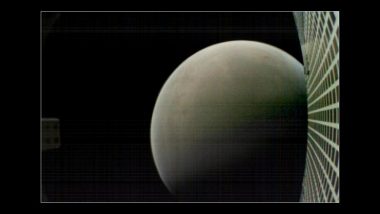Washington, November 27: After the successful launch of NASA's InSight on Mars on Monday, the spacecraft has sent signals to Earth indicating that its solar panels are open and collecting sunlight on the Martian surface.
NASA's Mars Odyssey spacecraft, that is currently orbiting the Red Planet, relayed the signals. It was received on Earth at about 5.30 p.m. PST (8.30 p.m. EST), the US space agency said in a statement.
Solar array deployment ensures the spacecraft can recharge its batteries each day. Odyssey also relayed a pair of images showing InSight's landing site. NASA Mars InSight Lander Mission to Teach Us More About Earth.
"The InSight team can rest a little easier tonight now that we know the spacecraft solar arrays are deployed and recharging the batteries," said Tom Hoffman, InSight's project manager at NASA's Jet Propulsion Laboratory in Pasadena, California.
"It's been a long day for the team. But tomorrow begins an exciting new chapter for InSight: surface operations and the beginning of the instrument deployment phase," Hoffman added.
On Monday, NASA's Interior Exploration using Seismic Investigations, Geodesy and Heat Transport (InSight) lander successfully touched down on the Red Planet after an almost seven-month, 300-million-mile (458-million-kilometre) journey from Earth.
InSight was launched from Vandenberg Air Force Base in California on May 5. The lander touched down on Monday, near Mars' equator on the western side of a flat, smooth expanse of lava called Elysium Planitia, with a signal affirming a completed landing sequence at approximately noon PST (3 p.m. EST).
The spacecraft's two-year mission will be to study the deep interior of Mars to learn how all celestial bodies with rocky surfaces, including Earth and the Moon, formed, NASA said.
InSight's twin solar arrays are each seven feet (2.2 meters) wide when they're open, the entire lander is about the size of a big 1960s convertible. Mars has weaker sunlight than Earth because it's much farther away from the Sun.
But the lander doesn't need much to operate: The panels provide 600 to 700 watts on a clear day, enough to power a household blender and plenty to keep its instruments conducting science on the Red Planet. Even when dust covers the panels -- what is likely to be a common occurrence on Mars -- they should be able to provide at least 200 to 300 watts.
"We are solar powered, so getting the arrays out and operating is a big deal. With the arrays providing the energy we need to start the cool science operations, we are well on our way to thoroughly investigate what's inside of Mars for the very first time," Hoffman said.
The panels are modelled on those used with NASA's Phoenix Mars Lander, though InSight's are slightly larger in order to provide more power output and to increase their structural strength. These changes were necessary to support operations for one full Mars year (two Earth years).
In the coming days, the mission team will unstow InSight's robotic arm and use the attached camera to snap photos of the ground so that engineers can decide where to place the spacecraft's scientific instruments. It will take two to three months before those instruments are fully deployed and send back data, NASA said.
In the meantime, InSight will use its weather sensors and magnetometer to take readings from its landing site at Elysium Planitia -- its new home on Mars.
With InSight landing successfully on Mars on Monday, NASA has successfully soft-landed a vehicle on the Red Planet eight times, the statement noted.
"Today, we successfully landed on Mars for the eighth time in human history," said NASA Administrator Jim Bridenstine.
"InSight will study the interior of Mars, and will teach us valuable science as we prepare to send astronauts to the Moon and later to Mars. This accomplishment represents the ingenuity of America and our international partners and it serves as a testament to the dedication and perseverance of our team. The best of NASA is yet to come, and it is coming soon," he added.
InSight will begin to collect science data within the first week after landing, though the teams will focus mainly on preparing to set InSight's instruments on the Martian ground. At least two days after touchdown, the engineering team will begin to deploy InSight's 5.9-foot-long (1.8-meter-long) robotic arm so that it can take images of the landscape.
InSight will operate on the surface for one Martian year, plus 40 Martian days, or sols, until November 24, 2020. The mission objectives of the two small MarCOs which relayed InSight's telemetry was completed after their Martian flyby.
(The above story first appeared on LatestLY on Nov 27, 2018 03:30 PM IST. For more news and updates on politics, world, sports, entertainment and lifestyle, log on to our website latestly.com).













 Quickly
Quickly











